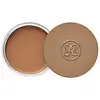What's inside
What's inside
 Key Ingredients
Key Ingredients

 Benefits
Benefits

 Concerns
Concerns

 Ingredients Side-by-side
Ingredients Side-by-side

Synthetic Fluorphlogopite
Mica
Cosmetic ColorantEthylhexyl Palmitate
EmollientSilica
AbrasiveZinc Stearate
Cosmetic ColorantDimethicone
EmollientTrimethylsiloxysilicate
EmollientZinc Oxide
Cosmetic ColorantSorbitan Sesquiisostearate
EmulsifyingTocopherol
AntioxidantIsopropyl Titanium Triisostearate
EmollientChlorphenesin
AntimicrobialIron Oxides
CI 77891
Cosmetic ColorantCI 77007
Cosmetic ColorantPhenyl Trimethicone
Skin ConditioningSilica
AbrasiveDimethicone
EmollientBis-Diglyceryl Polyacyladipate-2
EmollientIsononyl Isononanoate
EmollientMica
Cosmetic ColorantMicrocrystalline Wax
Emulsion StabilisingSorbitan Olivate
EmulsifyingSynthetic Fluorphlogopite
Synthetic Wax
AbrasiveOctyldodecanol
EmollientTriethoxycaprylylsilane
Sorbitan Isostearate
Emulsifying1,2-Hexanediol
Skin ConditioningPolyhydroxystearic Acid
EmulsifyingAluminum Hydroxide
EmollientEthylhexyl Palmitate
EmollientIsopropyl Myristate
EmollientIsostearic Acid
CleansingLecithin
EmollientPolyglyceryl-3 Polyricinoleate
EmulsifyingTocopheryl Acetate
AntioxidantCaprylyl Glycol
EmollientEthylhexylglycerin
Skin ConditioningTitanium Dioxide
Cosmetic ColorantIron Oxides
CI 77742
Cosmetic ColorantPhenyl Trimethicone, Silica, Dimethicone, Bis-Diglyceryl Polyacyladipate-2, Isononyl Isononanoate, Mica, Microcrystalline Wax, Sorbitan Olivate, Synthetic Fluorphlogopite, Synthetic Wax, Octyldodecanol, Triethoxycaprylylsilane, Sorbitan Isostearate, 1,2-Hexanediol, Polyhydroxystearic Acid, Aluminum Hydroxide, Ethylhexyl Palmitate, Isopropyl Myristate, Isostearic Acid, Lecithin, Polyglyceryl-3 Polyricinoleate, Tocopheryl Acetate, Caprylyl Glycol, Ethylhexylglycerin, Titanium Dioxide, Iron Oxides, CI 77742
 Reviews
Reviews

Ingredients Explained
These ingredients are found in both products.
Ingredients higher up in an ingredient list are typically present in a larger amount.
Dimethicone is a type of synthetic silicone created from natural materials such as quartz.
What it does:
Dimethicone comes in different viscosities:
Depending on the viscosity, dimethicone has different properties.
Ingredients lists don't always show which type is used, so we recommend reaching out to the brand if you have questions about the viscosity.
This ingredient is unlikely to cause irritation because it does not get absorbed into skin. However, people with silicone allergies should be careful about using this ingredient.
Note: Dimethicone may contribute to pilling. This is because it is not oil or water soluble, so pilling may occur when layered with products. When mixed with heavy oils in a formula, the outcome is also quite greasy.
Learn more about DimethiconeEthylhexyl Palmitate, also known as octyl palmitate, is created from 2-ethylhexyl alcohol and palmitic acid. It is a fatty acid ester.
The fatty acid content of Ethylhexyl Palmitate makes it an emollient. Emollients help soften and hydrate your skin by trapping moisture within.
Ethylhexyl Palmitate is also used to help improve the texture of cosmetics. It helps other ingredient dissolve in products and help disperse ingredients more evenly.
You'll likely find this ingredient in sunscreen, as it is often used to mix UV-blocking ingredients such as avobenzone and ethylhexyl triazone.
It can also help stabilize the fragrances in a product as a fragrance fixative.
Ethylhexyl Palmitate can be used to substitute mineral oil.
Due to its high fatty acid content, it may not be fungal-acne safe.
Learn more about Ethylhexyl PalmitateMica is a naturally occurring mineral used to add shimmer and color in cosmetics. It can also help improve the texture of a product or give it an opaque, white/silver color.
Serecite is the name for very fine but ragged grains of mica.
This ingredient is often coated with metal oxides like titanium dioxide. Trace amounts of heavy metals may be found in mica, but these metals are not harmful in our personal products.
Mica has been used since prehistoric times throughout the world. Ancient Egyptian, Indian, Greek, Roman, Aztec, and Chinese civilizations have used mica.
Learn more about MicaSilica, also known as silicon dioxide, is a naturally occurring mineral. It is used as a fine, spherical, and porous powder in cosmetics.
Though it has exfoliant properties, the function of silica varies depending on the product.
The unique structure of silica enhances the spreadability and adds smoothness, making it a great texture enhancer.
It is also used as an active carrier, emulsifier, and mattifier due to its ability to absorb excess oil.
In some products, tiny microneedles called spicules are made from silica or hydrolyzed sponge. When you rub them in, they lightly polish away dead skin layers and enhance the penetration of active ingredients.
Learn more about SilicaSynthetic Fluorphlogopite is the synthethic version of mica. It consists of fluorine, aluminum and silicate.
Synthetic Fluorphlogopite is used to add volume to products.
It is considered non-irritating on the skin.
Learn more about Synthetic FluorphlogopiteThis ingredient is a combination of red, black, and yellow iron oxide pigments. This combination of colors is usually found in foundation, because it results in a "skin" color.